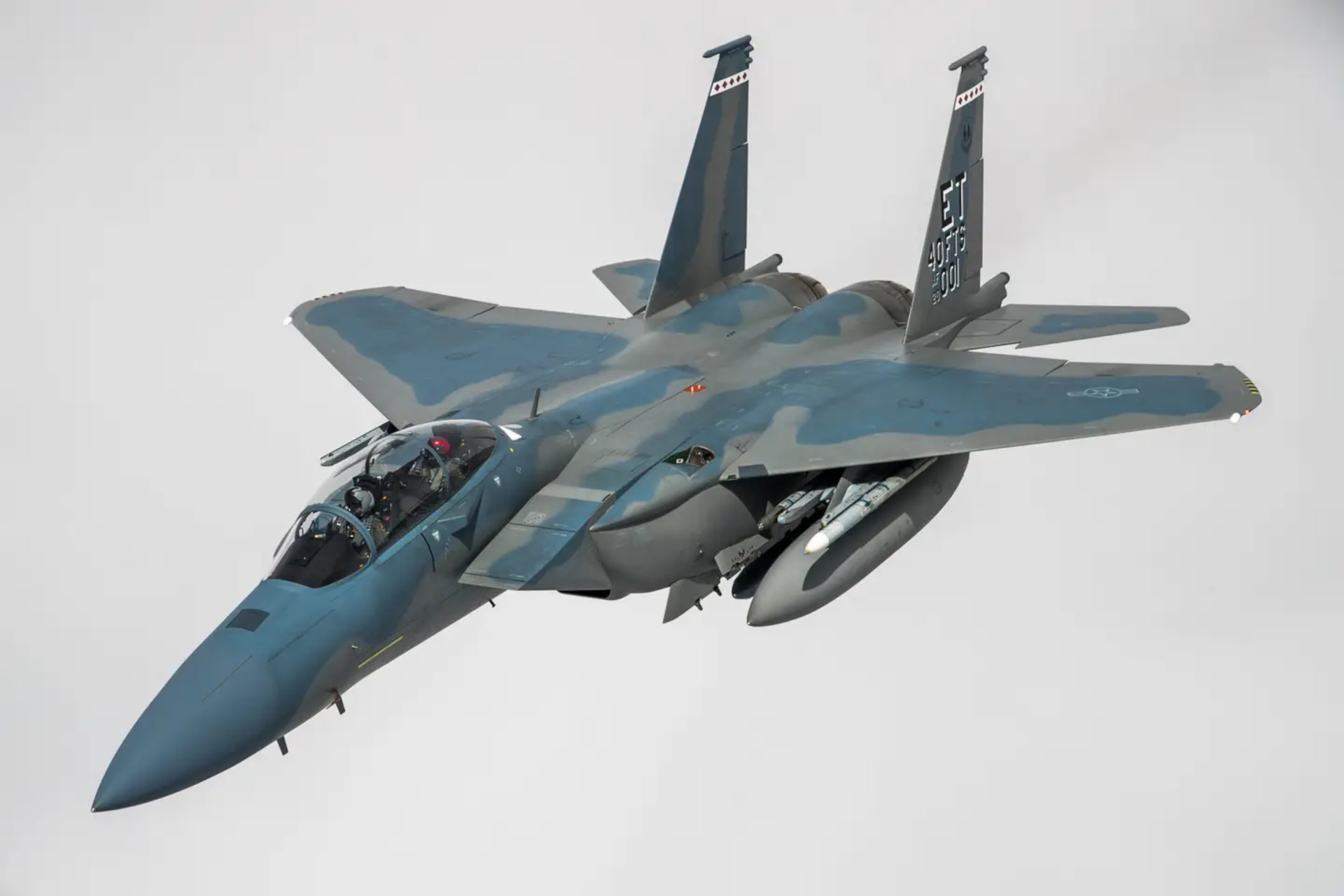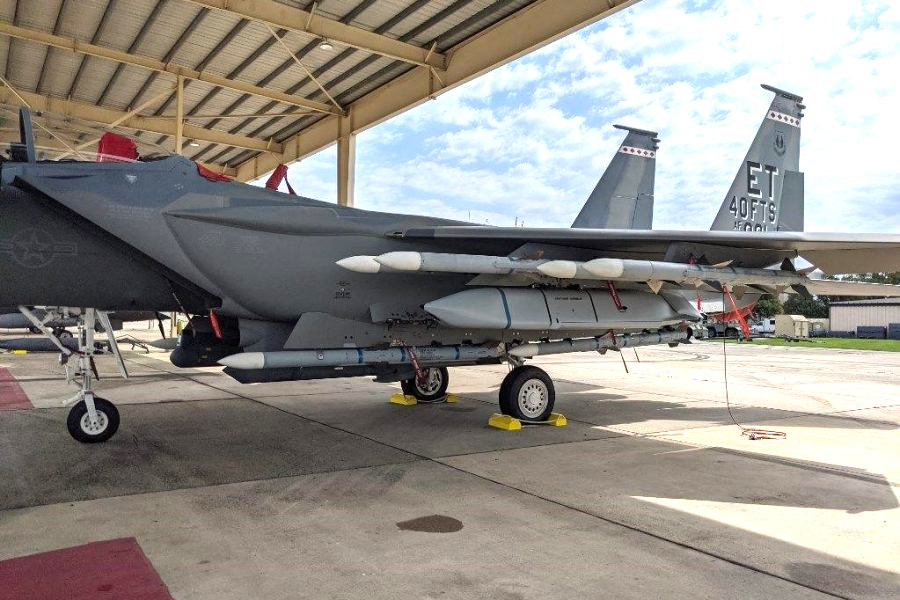Poland has an active interest in buying F-15EX Eagle II fighters, according to the jet’s manufacturer Boeing. This announcement comes amid continued uncertainty about the U.S. Air Force’s F-15EX plans and a massive Polish defense spending spree that has already included the purchase of new combat aircraft.
Boeing made an announcement about its pitch to sell an unspecified number of F-15EXs to Poland earlier today. To date, the only customer for the Eagle II is the U.S. Air Force, which has received two of these fighters already and is currently planning to acquire a total fleet of 104 of the jets. Last month, the Indonesian government made a formal commitment to buy 24 examples of a country-specific F-15EX derivative known as the F-15ID, but that deal has not yet been finalized.
“Poland’s interest in the F-15EX confirms its dedication to the preparedness and effectiveness of its military forces,” Tim Flood, Boeing’s senior director of Global Business Development for Europe and Americas, said in a statement. “The F-15EX offers superior interoperability, supportability, and affordability along with a robust industry plan that would support Poland’s goal of developing independent defense capabilities.”

“The F-15EX is the world’s most advanced fighter with unmatched capability, lethality, and survivability and is the right fit to strengthen Poland’s security needs,” Rob Novotny, the director of Business Development for Boeing’s F-15 program, also said. “Through enhanced interoperability with U.S. and NATO forces, capacity for technology growth, and a 20,000+ hour economic operational airframe life, Poland can expect the F-15EX to win in existing and future threat environments.”
The F-15EX is the most advanced version of the F-15 in production today and features a slew of improved features and capabilities over older Eagles, including a highly capable active electronically-scanned array (AESA) radar and an advanced electronic warfare suite. Boeing regularly touts the jet’s significant combat range and payload capacity compared to other U.S. and foreign fighters on the market.

Boeing’s press release today regarding Poland’s interest in the F-15EX also notably reiterates a long-standing talking point about the Eagle II’s “ability to carry advanced hypersonic weapons.”
How exactly the F-15EX might fit into the Polish Air Force’s modernization plans is not immediately clear. At present, its tactical combat jet fleets consist of Block 52+ F-16C/D Viper and MiG-29 Fulcrum fighters and Su-22 Fitter swing-wing combat jets. Poland is also in the process of acquiring F-35A Joint Strike Fighters and has recently begun receiving South Korean FA-50GF light combat jets. Authorities in Poland plan to ultimately retire the MiG-29s, some of which have already been transferred to Ukraine, and the Su-22s.

Even a relatively small fleet of F-15EXs could offer capabilities to the Polish Air Force that its existing F-16C/Ds or its future stealthy F-35As can’t necessarily provide. As already noted, the Eagle II offers significantly greater range and payload capacity that could be particularly useful for Poland when it comes to protecting the country’s airspace, where stealth would not necessarily be as critical, and increasing its capacity to conduct stand-off strikes against surface targets. This is more or less the same argument that the U.S. Air Force initially presented to justify its own F-15EX acquisition plan, as The War Zone has explored in depth in the past.
The long-range and stand-off strike capabilities the F-15EX offers would be particularly useful in the context of expeditionary operations, but are also applicable to fighting from one’s home turf in some respects, as well.
It’s also worth noting that the U.S. Air Force has significantly truncated its planned F-15EX purchases and otherwise curtailed the program, as you can read more about here.
For Poland, specifically, F-15EX could be part of the equation when it comes to the country possibly joining NATO’s nuclear weapons sharing arrangements. Under that program, the U.S. military has B61 nuclear gravity bombs stockpiled at multiple bases across Europe and has procedures in place to make those weapons available to certain members of the alliance in the event of a sufficiently severe crisis.
The F-15EX is derived from the F-15E Strike Eagle, which the U.S. Air Force has already cleared to employ multiple variants of the B61, including the newest B61-12 version. The Strike Eagle is also one of only a select number of delivery platforms that will be able to take advantage of the new precision guidance capability found on the B61-12. F-16s configured to employ B61s, which form the bulk of NATO’s current nuclear-capable fleets, will only be able to use these bombs in their unguided mode. Nuclear-capable F-35As will be able to make use of the guided functionality

Poland is not currently a member of NATO’s nuclear weapon sharing program, but has expressed an interest in at least hosting weapons in the past. This policy position has been underscored by concerns over Russia’s decision last year to forward-deploy nuclear weapons in Belarus in cooperation with that country’s military.
“NATO is a nuclear treaty organization; it should be much more proactive and stronger to the Russians,” Polish Gen. Rajmund Andrzejczak, Chief of the General Staff of the country’s armed forces, said just this week at the Karpacz Economic Forum.
There is certainly a question of whether or not Poland can afford to acquire, operate, and sustain four distinct fleets of combat jets, F-15EXs, F-35As, F-16C/Ds, and FA-50GFs. At the same time, the country has long been engaged in a massive modernization effort across its entire armed forces, an effort that has only expanded in the wake of Russia’s all-out invasion of Ukraine. Just in the past year or so, the Polish government has moved ahead with a number of major defense deals, including large purchases of fixed-wing aircraft, helicopters, tanks and other armored vehicles, and much more.

Poland is now expected to order up to 96 AH-64E Apache attack helicopters, another Boeing product, valued at around $12 billion, which would make it the second largest operator of the type behind the U.S. Army. The country is also in the process of establishing a very robust integrated air defense system that is set to include billions of dollars worth of U.S.-made Patriot surface-to-air missile systems and a modern networked command and control backbone called the Integrated Battle Command System (IBCS).
In addition, Poland has been establishing important partnerships with foreign defense contractors. Just this week, Polska Grupa Zbrojeniowa (PGZ) and Javelin Joint Venture (JJV), a partnership between Raytheon and Lockheed Martin, signed a Memorandum of Understanding (MOU) regarding the future production of certain components of the Javelin anti-tank missile and assembly of those weapons in Poland. Javelin has become something of a household name worldwide thanks to its heavy use by Ukrainian forces in the current conflict with Russia.
“Boeing has been present in Poland for more than 30 years,” the company highlighted in its own press release today regarding the F-15EX. “With headquarters in Warsaw, Boeing Digital Solutions & Analytics operations in Gdańsk and Parts & Distribution Services in Rzeszow, Boeing employs more than 1,000 people in Poland and is currently establishing strong engineering capability in all of its three locations.”
Furthermore, Poland is now the top spender on defense as a percentage of GDP within the NATO alliance, beating out even the United States. This year, the country expects to spend 3.9 percent of its GDP on defense compared to the U.S. government’s 3.49 percent, according to official NATO data. Poland is one of just 11 of NATO’s 31 members that meet the alliance’s two percent GDP defense spending goal and one of just three (the others being the United States and Greece) that spends three percent of its GDP or more in this regard. Polish authorities have said that they are looking to eventually push this spending to at least four percent of the country’s GDP.

Given the aforementioned situation with the U.S. Air Force’s F-15EX program, a sale of Eagle IIs could also be very important for Boeing. The company announced earlier this year that it would be ending production of its other flagship fighter, the F/A-18E/F Super Hornet, in 2025 and refocusing those resourcing into other current and future projects. If it were to purchase Eagle IIs, Poland would become the first European operator of any F-15 variant since the original version was introduced in the 1970s, too.
It remains to be seen whether or not the Polish Air Force ultimately acquires F-15EXs and, if so, in what quantities. At the same time, the acquisition of these aircraft would certainly fit in many ways with the country’s already ambitious defense modernization plans.
Contact the author: joe@thedrive.com
